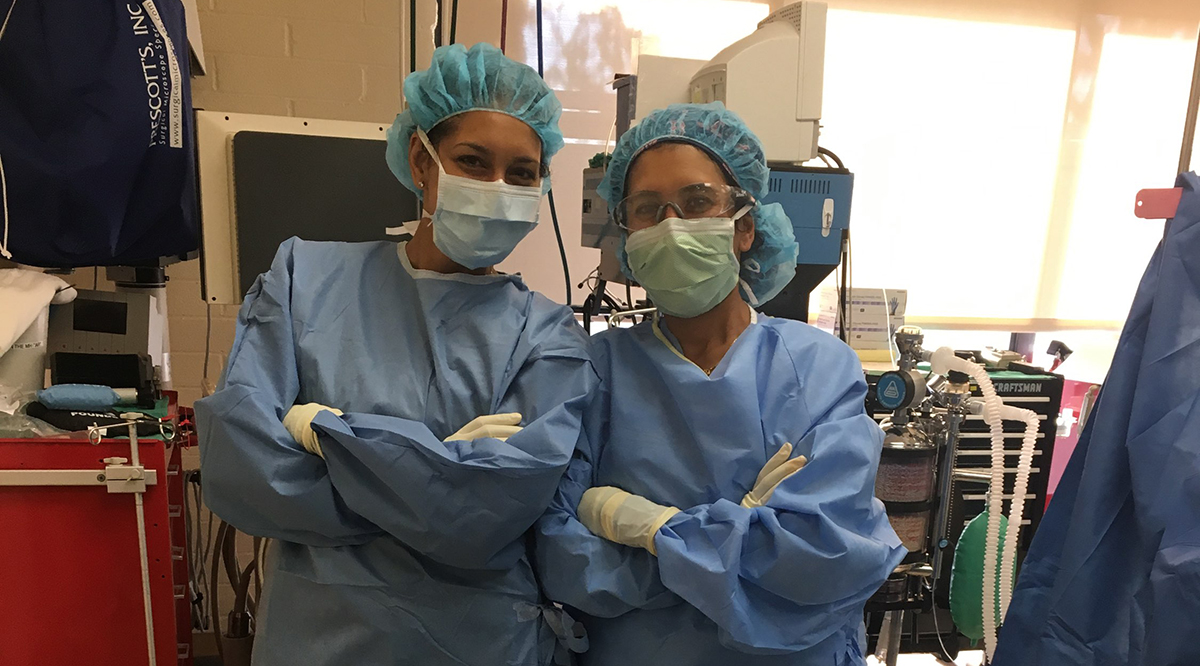
As a medical trainee pursuing general surgery at Vanderbilt University Medical Center in Nashville, Jaime Bohl, MD, struggled to operate equipment the way her male attending physicians taught her.
Her hands were too small to drive the endoscope into the colon and easily adjust it because of the position of the buttons.
It wasn’t until the chair of her fellowship program, a female surgeon, showed her how to adjust her pinky to free up her other fingers that she was able to make the instrument's use less cumbersome.
“She said to me, ‘I’ll show you how to scope like a chick,’” Bohl recalls.
Now, as the chair of colon and rectal surgery at Virginia Commonwealth University School of Medicine in Richmond, Bohl teaches all the residents under her tutelage — not just the women — the same technique.
“As a trainee — a female trainee — you recognize that the equipment and the things that you’re learning how to do aren’t quite right for your stature or your body size, but you adapt because … this is the equipment that is given to you,” Bohl says. “You adjust or make do.”
Bohl, who has been practicing surgery for 15 years, regularly sees a chiropractor to address her back pain, an issue she attributes to having to adapt to surgical environments not made for her 5’3” stature.
It’s one of several issues that women surgeons have raised about surgical equipment — from gloves and gowns to staplers and bed heights — that is designed to fit men and not women.
“Not having equipment fit you might sound like a small inconvenience to some, but it communicates that you don’t belong, and it’s costing us talent,” says Diana Lautenberger, director of gender equity initiatives for the Association of American Medical Colleges. “Inclusion is about every aspect of the organization, and the profession writ large, functioning with all people in mind, and valuing and recognizing the benefits the diversity of our workforce brings.”
Made for men
Women made up about 36% of the physician workforce in 2019, according to the AAMC’s latest available data. The proportion is expected to rise, as women accounted for just over half of all medical school students the same year.
But even as the percentage of women doctors increases, surgical specialties remain male-dominated, with only 22% of general surgeons and less than 6% of orthopedic surgeons being women.
This is despite studies that suggest patients treated by surgeons who are women are slightly less likely to have bad post-surgery outcomes. One study found that women who were treated by male surgeons had a 32% higher chance of death post-surgery than those treated by women.
“I think a lot of women in medical school are scared away from general surgery … because it has a reputation for discouraging women, especially those who want to have a family,” says Micaela Weaver, DO, a board-certified general surgeon, fellowship-trained breast surgical oncologist, and clinical instructor in surgery at Warren Alpert Medical School of Brown University in Providence, Rhode Island.
Weaver says that during her 5 years of residency, surgical gloves were rarely ordered in her size and she was rebuked for not having the grip strength to operate the surgical stapler with one hand.
“In residency, the impact of having those experiences just feeds into imposter syndrome, doubt, and lack of self-confidence,” she says.
Bohl says that mis-sizing of equipment can also be a safety issue — for both the physician and the patient.
When the surgical bed doesn’t go low enough, Bohl must stand on steps that limit her balance and compromise her ergonomics.
“It’s such a common theme talking to all the [women] surgeons across different backgrounds,” says Sarah Temkin, MD, a gynecologic oncologist who is leading 1001 Cuts, a storytelling project that highlights the discrimination that women in surgery face. “The instruments [are] not built for you.”
“If we’re going to encourage women to continue to go into surgery and to stay in surgery or other fields of medicine in which they are exposed to radiation, we need to talk and work with manufacturers.”
Kimberly Templeton, MD
University of Kansas Medical Center
One small 2014 study found that surgeons who were women were more likely to receive medical treatment on their hands and report shoulder, neck, and back pain than their male counterparts, which the study authors suggested could be remedied by redesigning laparoscopic equipment and bed heights to be more ergonomic for smaller surgeons.
“It’s self-care,” Bohl says of ensuring the surgical equipment is the right size. “But it’s also patient care making sure you’re at your best to take care of the patient.”
In some fields, the risk of harm extends beyond ergonomic issues.
Kimberly Templeton, MD, a professor of orthopedic surgery and residency director at the University of Kansas Medical Center in Kansas City, didn’t realize that the lead gowns that she had used to protect herself from radiation during procedures did not fully protect women's breasts until she was peer-reviewing a paper on the issue.
“I was the first woman who trained in [my residency] program,” says Templeton, who served as president of the American Medical Women’s Association from 2016 to 2017. “It wasn’t something anyone thought about.”
The 2016 study pointed out that women orthopedic surgeons get breast cancer at a higher rate than the general population of women in the United States and found that the radiation-blocking gowns fail to protect the upper quarter of breast tissue near the armpits.
While there are sleeves designed to add to the gown for protection, they are cumbersome and can make it more challenging to perform surgery, Templeton says.
“It’s a real shame, [because] we’re losing good women who would make phenomenal surgeons.”
Micaela Weaver, DO
Warren Alpert Medical School of Brown University
The gowns also often don’t fit bodies in the later stages of pregnancy, a major concern because radiation exposure to a fetus can cause negative health effects.
Templeton believes that manufacturers who make gowns should consult the women who wear them to develop a design that both protects the wearer and allows them to perform their job functions.
“I think it’s going to have to be something where we work collectively at a national level,” Templeton says. “If we’re going to encourage women to continue to go into surgery and to stay in surgery or other fields of medicine in which they are exposed to radiation, we need to talk and work with manufacturers.”
Changing the culture
While the issue of equipment not fitting women surgeons is a tangible barrier, some surgeons believe that it is representative of a bigger problem: that women aren’t welcome in surgery.
“The message is you need to change yourself to make this work,” says Arghavan Salles, MD, PhD, a minimally invasive and bariatric surgeon in the Department of Medicine at Stanford University School of Medicine in California. “It’s not necessarily that the environment welcomes you.”
Many surgical programs expect surgeons to be almost superhuman, encouraging them to perform long operations without breaks and disadvantaging people who ask for accommodation, she adds.
This puts the onus on the surgeons, particularly women surgeons, to advocate for themselves and seek out mentors who can help them adapt to an unwelcoming environment.
“It’s a real shame, [because] we’re losing good women who would make phenomenal surgeons,” Weaver says. “Those of us mentoring medical students on their rotations, [it’s important] for us to champion the fact women can be excellent general surgeons, just like men.”
Salles believes that most medical schools are surpassing many residency programs and medical practices in their emphasis on creating a humane work environment for students.
Long-term change will require a culture shift in the field.
“We want to take the best care we can of these patients,” Salles says. “It’s frustrating to be limited by things that shouldn’t be a problem anymore.”
